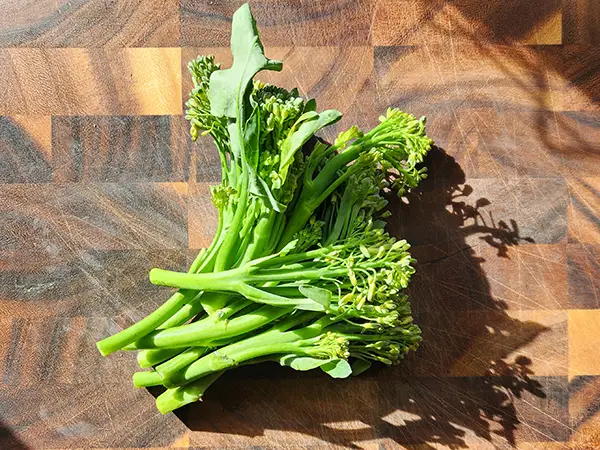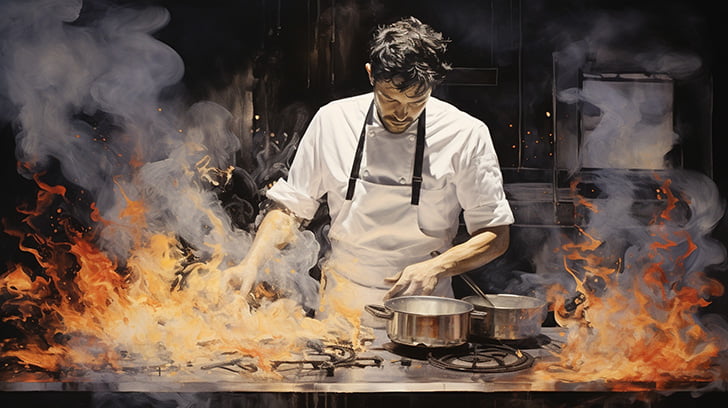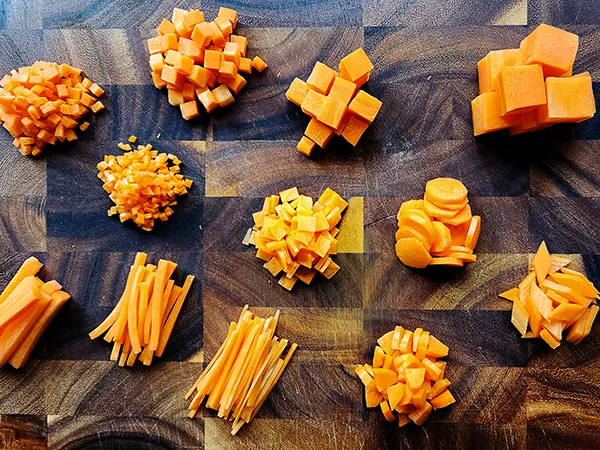How to cut onions Like a Pro Chef: 10 Great Ways
Well hello there! It’s your pal Ksenija here, back with another fun kitchen tutorial. As a chef with over a decade of chopping experience across Europe’s finest restaurants, I’ve picked up more than a few tricks for chopping an opinion.
In this article, I’ll walk you through pro tips for expertly chopping onions anytime. Even if you’ve found onion chopping frustrating and time-consuming before, these handy tips will upgrade your skills dramatically.
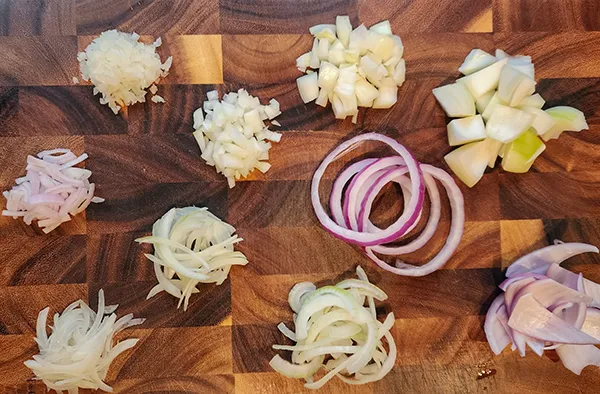
You’ll discover effortless ways to dice, slice, and chop onions like a seasoned chef! Say goodbye to amateur onion-cutting days and let’s get you chopping onions confidently for all your recipes.
So grab your gear and let’s learn how to cut onions!
How to Prep onions before chopping?
Before cutting onions, let’s go over some key prep steps to set you up for success. Here are step-by-step instructions on how to prep an onion for cutting.
Get your equipment ready
Prepare a cutting board, a large chef’s knife, and a pairing knife
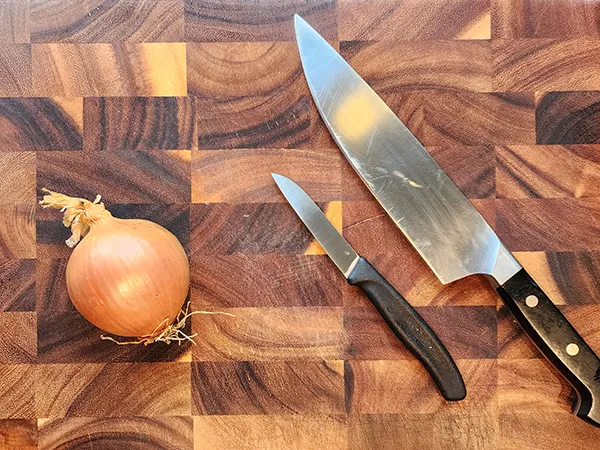
Use a chef’s knife to cut thin slices away from the stem and root ends of the bulb

Use a pairing knife to remove the outer layers of the onion skin
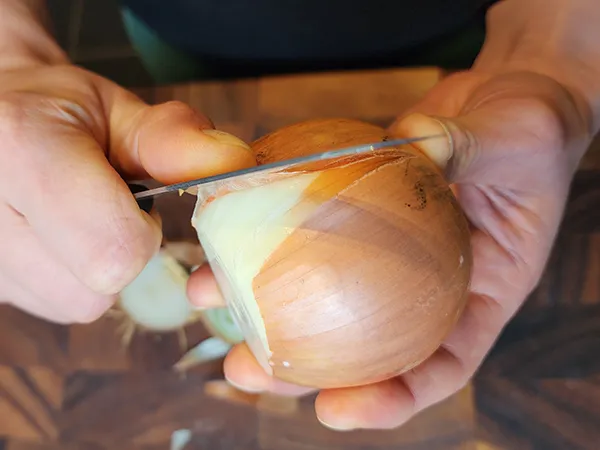
Catch the peel between the pad of your thumb and the flat side of your knife and pull away the peel

Now that your onions are ready, it’s time to learn the juicy part – the chopping techniques!

Okay, let’s talk TECHNIQUE…
How to cut onions?
I’ve broken down the main cutting methods into three sections: strip cuts, dice/cube cuts, and special cuts. So it is a bit easier to digest for you. Don’t forget to use a very sharp knife.
Strip Cuts
Let’s start with strip cuts or sliced onions! Strip cuts don’t require a lot of finesse, making them the perfect place to begin mastering your knife skills.
Julienne- My favorite way of cutting an onion.
Start with trimmed, peeled onions. Cut an onion into half.
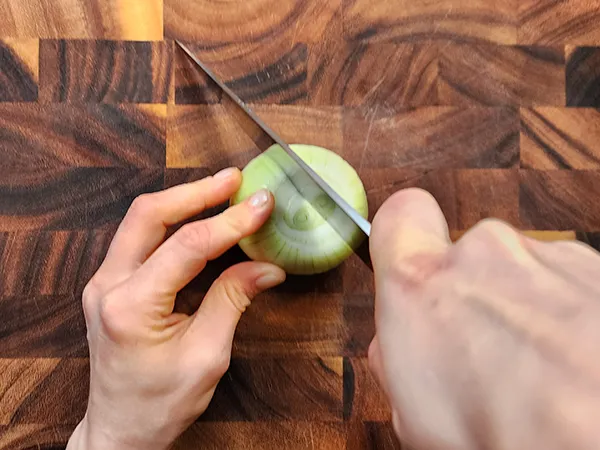

Lay the onion flat on the cutting board.

When slicing vertically into the onion, start with your knife at a lower angle, closest to the cutting board.

Slowly adjust the knife to a higher angle as you slice upwards towards the top of the onion. This creates an oval shape with tapered ends. Try to maintain consistency in their thickness around 1/8 inch (3mm).

For the right julienne size, aim for approximately 1/8 inch (3mm) thin slices.
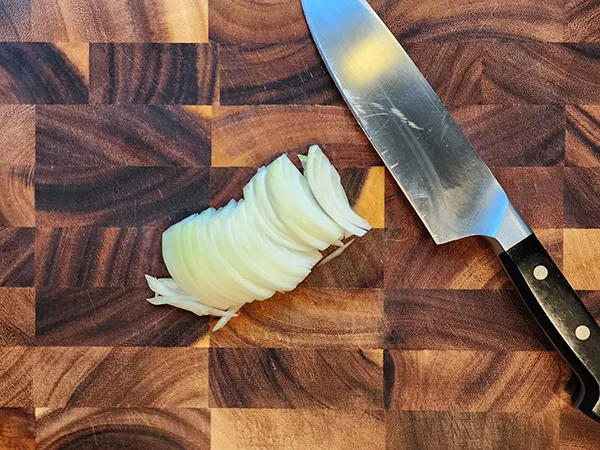
Fine julienne – for salads, soups, and garnish.
Start with trimmed, peeled onions. Cut an onion into half.

Lay the onion flat on the cutting board

When slicing vertically into the onion, start with your knife at a lower angle, closest to the cutting board.

Slowly adjust the knife to a higher angle as you slice upwards towards the top of the onion. This creates an oval shape with tapered ends. Try to maintain consistency in their thickness around 1/16 inch (1.5 mm).
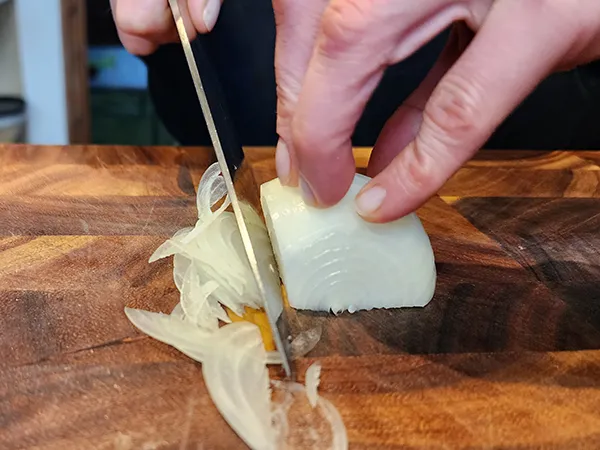
For the fine julienne size, aim for approximately 1/16 inch (1.5mm) thin slices.
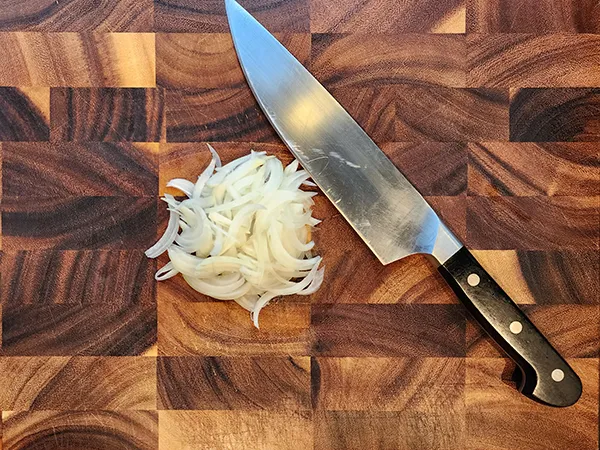
Half rings – for rustic-looking dishes, stews, and soups.
Start with trimmed, peeled onions. Cut an onion into half.

Lay the onion flat on the cutting board
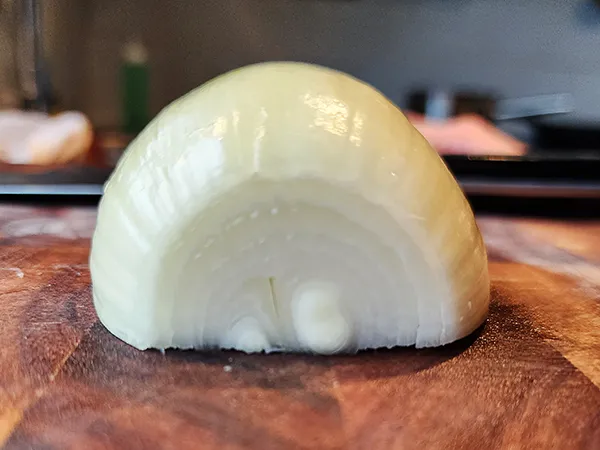
This time we slice the onion across to get half-half-moon. Try to maintain consistency in their thickness so they cook evenly.
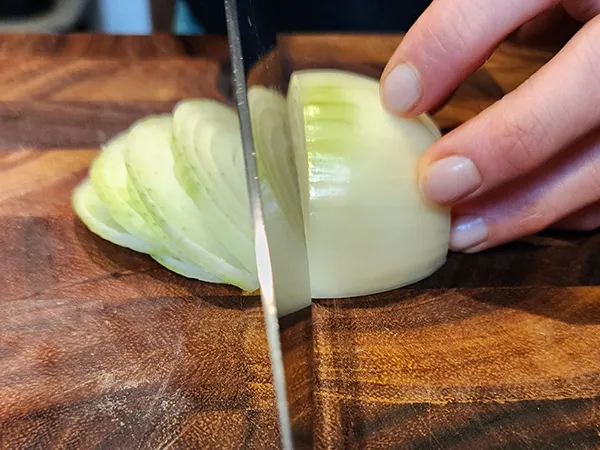
The thickness will depend on the chosen dish but aim somewhere around 1/16 inch 1/4 inches (1.5mm-6mm)
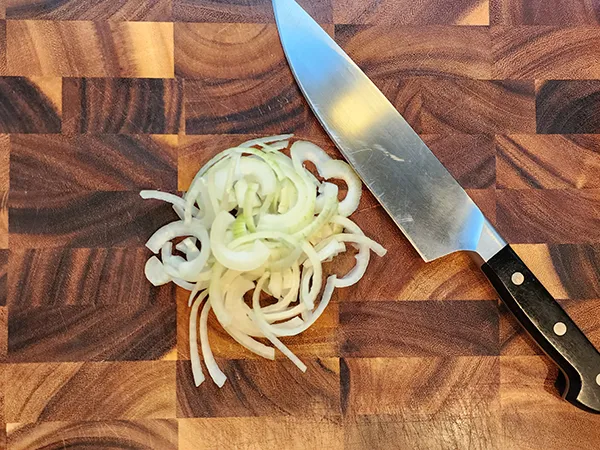
Dice/Cube Cuts
In the kitchen world, the name given to the minced onion is Burnoise. I will also show you how to get small, medium, and large dice.
Brunoise – Finely diced onions perfect for garnish, salsas, and sauces.
Start with trimmed, peeled onions. Cut an onion into half.

Lay the onion flat side on the cutting board

When slicing vertically into the onion, leave the root end intact. Try to maintain consistency in their thickness around 1/8 inch (3mm).
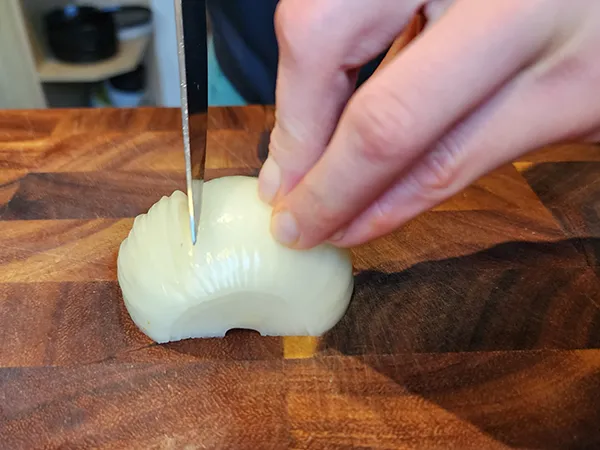
Then turn your onion 90 degrees and repeat even cuts across the same thickness around 1/8 inch (3mm).


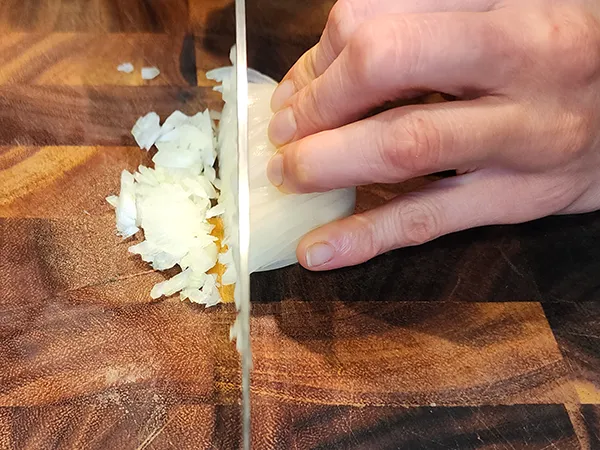
The thickness will depend on the chosen dish but aim somewhere around 1/16 inch – 1/8 inches (1.5mm-3mm)

Small dice – cubes for soups, and salads.
Start with trimmed, peeled onions. Cut an onion into half.

Lay the onion flat side on the cutting board

When slicing vertically into the onion, we do not cut into the root, try to maintain consistency in their thickness around 1/4 inch (6mm).
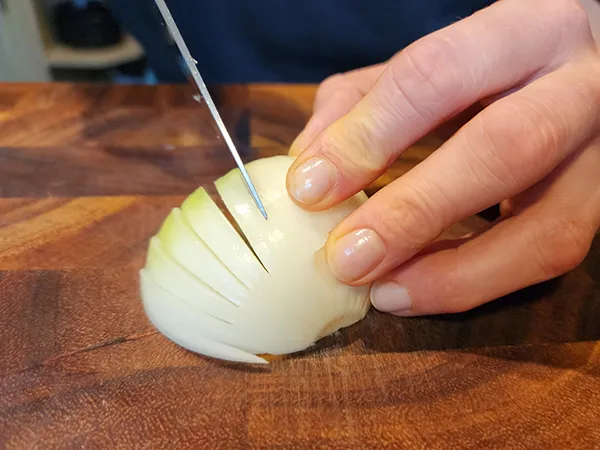
Then turn your onion 90 degrees and repeat even cuts across the same thickness around 1/4 inch (6mm).
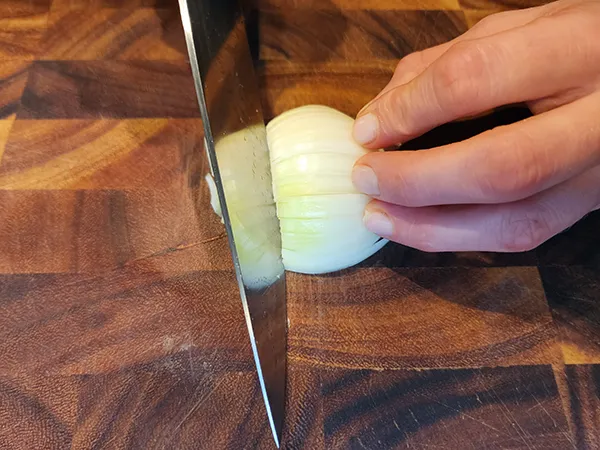
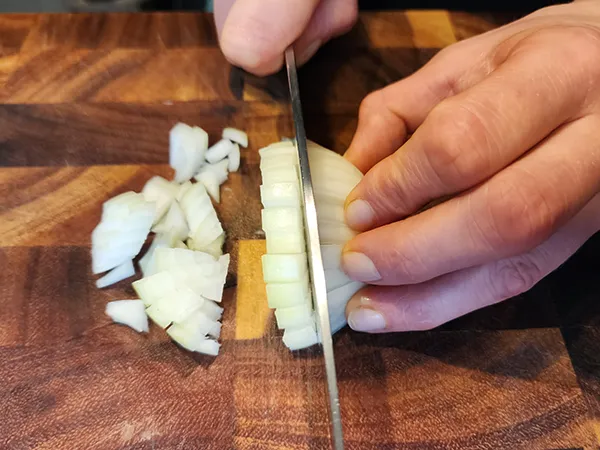
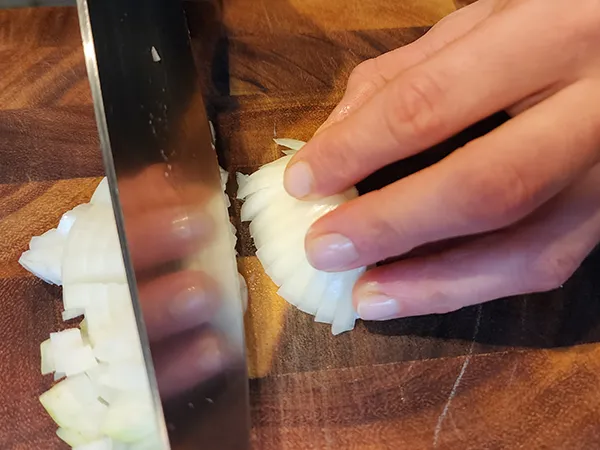

For the small sized dice cut, aim for approximately 1/4 x 1/4 x 1/4 inches (6mm x 6mm)

Medium dice – cubes for stews, roasting.
Start with trimmed, peeled onions. Cut an onion into half.

Lay the onion flat on the cutting board

When slicing vertically into the onion, we do not cut into the root, try to maintain consistency in their thickness of around 1/2 inch (12mm).
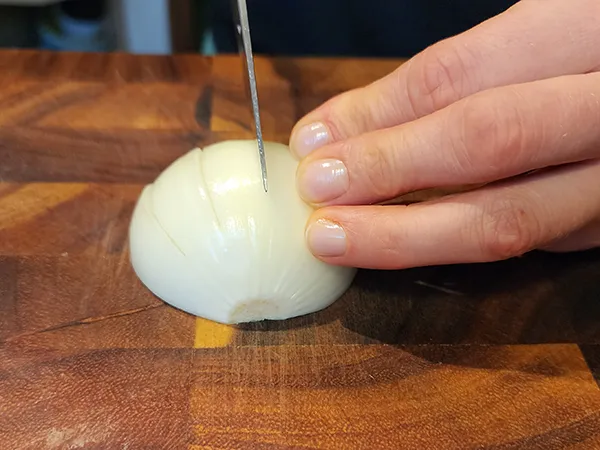
Then turn your onion 90 degrees and repeat even cuts across the same thickness around 1/2 inch (12mm).


For the small-sized dice cut, aim for approximately 1/2 x 1/2 inches (12mm x12mm)
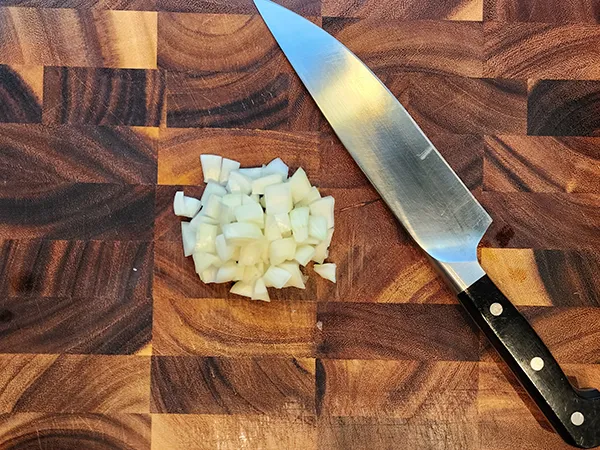
Large dice – perfect cubes for oven stocks, roasting, and stews. Approximate size 3/4 x 3/4 x 3/4 inch (20mm x 20mm x 20mm)
Start with trimmed, peeled onions. Cut an onion into half.

Lay the onion flat on the cutting board.
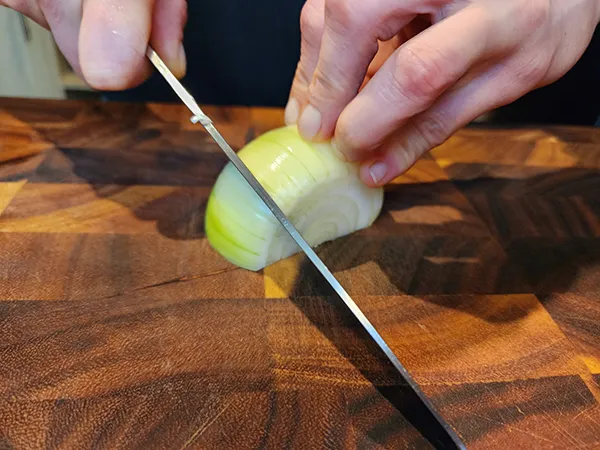
When slicing vertically into the onion, try to maintain consistency in their thickness around 3/4 inch (20mm) usually two cuts.

Then turn your onion 90 degrees and repeat even cuts across the same thickness around 3/4 inch (20mm) also two cuts.

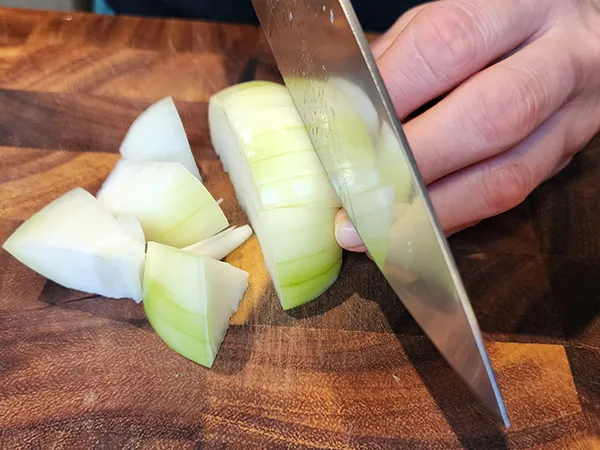
For the large diced carrots, aim for approximately 1/2 x 1/2inches (20mm x 20mm)

Special Cuts
Onion rings – perfect for marinating, presentation, or specific recipes
Start with trimmed, peeled whole onion. Lay the onion flat on the cutting board and grab it in a claw so it does not roll around.

Then slice across to get rings.
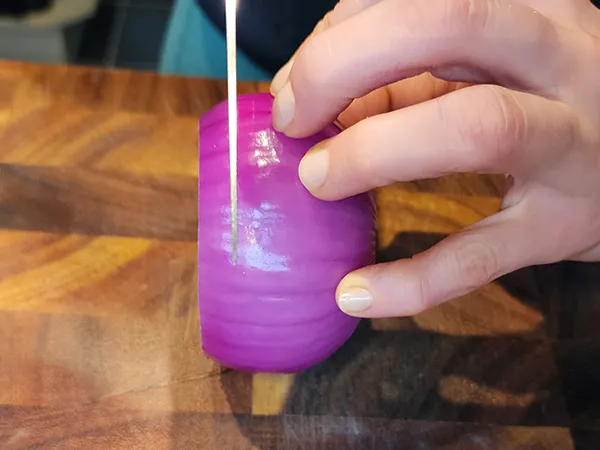
Try to maintain consistency in their thickness so they cook evenly.

The thickness will depend on the chosen dish but aim somewhere around 1/16 inch 1/4 inch (1.5mm-6mm) for garnish and about 1/2 inch to 3/4 inch for big onion rings
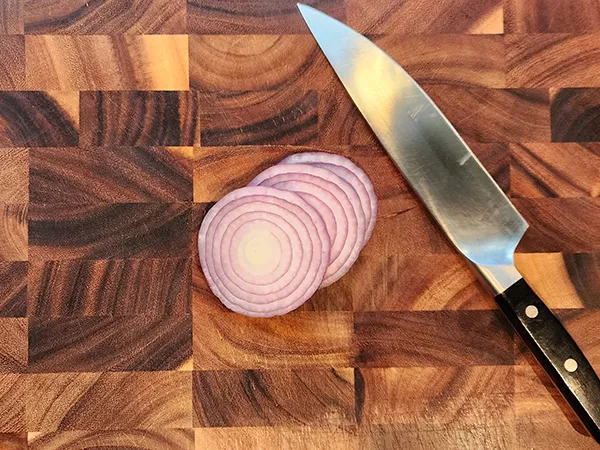
Triangles– perfect for grilling
Start with trimmed, peeled onions. Lay the onion flat on the cutting board.

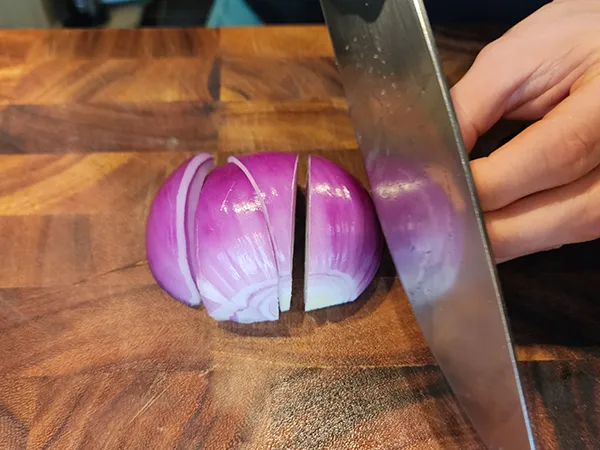
Slice into an onion at an angle. Repeat the cut.

Then divide the layers.

Short Strips – perfect for showing off
Start with trimmed, peeled onions. Cut an onion into half. Lay the onion flat on the cutting board.

When slicing vertically into the onion, this time we do not cut into the root. Try to maintain consistency in their thickness around 3/4 inch (20mm).

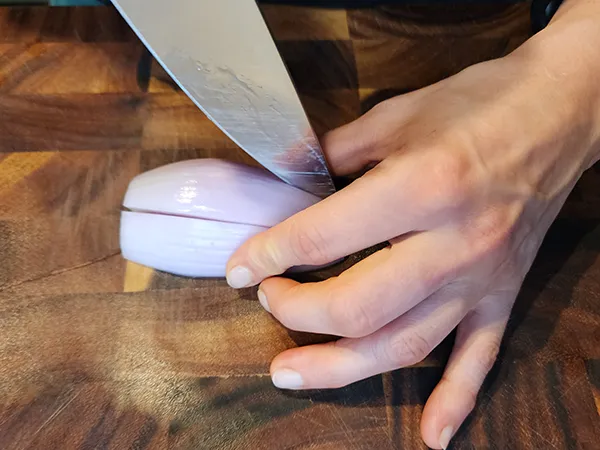
Then turn your onion 90 degrees and repeat even cuts across. Try to maintain a thickness of around 1/8 inch (3mm).
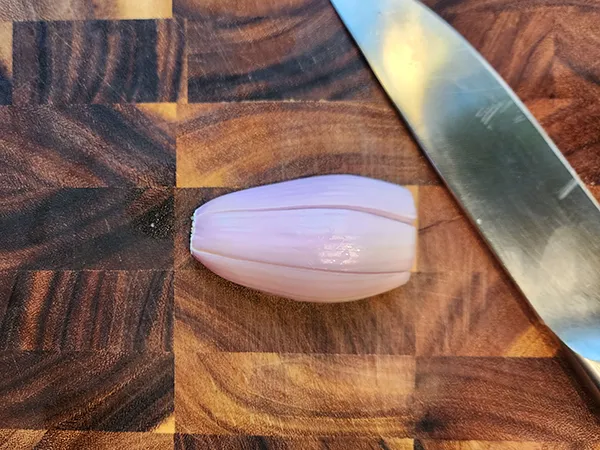


There you will have little matchsticks perfect for garnish and salads.
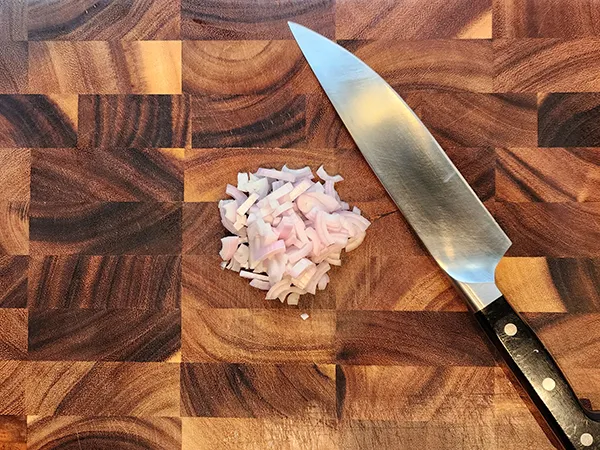
Storing Chopped Onions
Alrighty, so you just chopped yourself a good heap of onions – nice! Now we gotta make sure to store cut onions correctly so they don’t stink up your whole fridge!

Here are 2 ways to do that:
- Once you’re done, be sure to store your chopped onions in an airtight container in the fridge.
- You could also store it in any bowl covered with plastic wrap kept in the fridge.
Don’t leave raw chopped onions uncovered in the refrigerator. The odor can seep into and change the flavor of other foods badly.
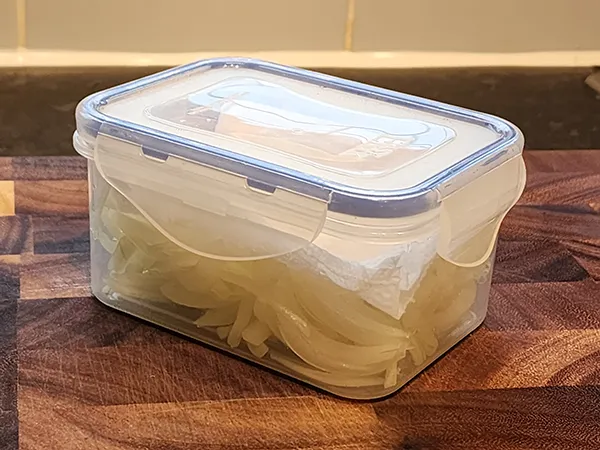
For best results, use an airtight container and refrigerate. Use chopped onions within a few days to retain freshness and flavor.
How Do Chefs Chop Onions Without Crying?
Let’s kick this off with some background – onions contain sulfur compounds that cause irritation and crying when released during chopping. So how do professional chefs slay mounds of onions without sobbing or stinging eyes? Speed and efficiency!
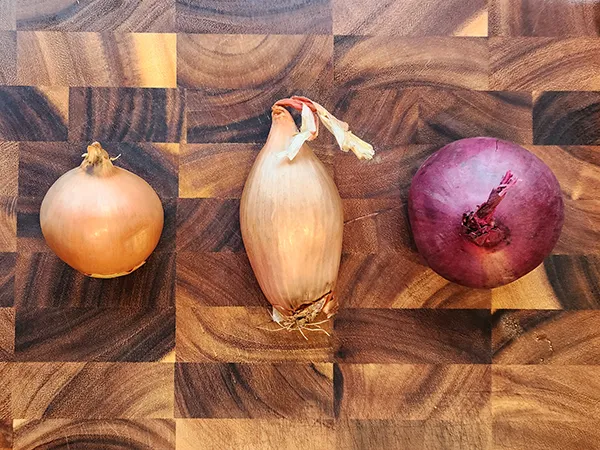
The faster you can make those cuts, the less eye-watering compound exposure.
Now let’s get into more tricks for no-tear chopping success:
Chopping Tips
- Refrigerate onion beforehand to reduce released vapors
- Use a RAZOR SHARP knife for clean, fast slices
- Always cut away from your fingers and face
Crying Prevention Tips
- Run the knife under COLD WATER frequently while chopping
- Set up a fan to blow fumes away
- Pop on some swim goggles for eye protection (extreme cases)
- Light a candle close by to neutralize sulfur (not my favorite)
See chefs have this whole onion thing down to a science! Pre-chill the onion, and get your knives and workspace ready for speedy slicing. Make your blade wet when chopping by holding it under cold running water frequently. Most importantly, work swiftly and keep that knife sharp and skills on point!
Types of onions
There are many different types of onions, ultimately very similar in taste.
Yellow Onions – Most common onion. Great for caramelizing, soups, and stews. Adds rich, savory depth.
Red Onions – Vibrant color. Crisp texture when raw. Brightens the flavor of salads, and salsas.
White Onions – Very crisp and mild taste. Excellent roasted, grilled, or eaten raw.
Spanish Onions – Impressively large. Sweet, mild flavor delicious raw or grilled.
Shallots – Small teardrop shape. Delicate onion-garlic flavor, and aromatics.
Pearl Onions – Tiny, bite-sized spheres. Sweet pickled onion classics, perfect appetizers.
Cipollini Onions – Distinctively flat, disc-like shape. Sweet, rich, and caramelized beautifully.
Spring/Scallions – Long green shoots, small white bulb. The delicate onion flavor is perfect for garnish.
Roscoff Onions – Rare red heirloom. Raw in salads. Grills well with a bold taste when cooked.
Vidalia onions -Round to flattened shape with light yellow/white papery skin. It works well in salads, sandwiches, burgers, onion rings, and as a topping for meat and fish.
Health Benefits
Onions contain powerful health-promoting compounds and have been shown to provide a variety of benefits. They are low in calories yet high in vitamin C, B6, folate, and numerous antioxidants. Onions have demonstrated antibiotic, anti-inflammatory, and antiviral properties. Studies indicate they may help lower blood sugar levels, reduce heart disease risk factors, combat infections, and decrease cancer risk. Their potent sulfur-containing compounds give onions free radical scavenging abilities. This versatile vegetable adds a nutritional punch to recipes, salads, soups, and more while boosting flavor. Adding more onions to your diet can boost your overall health in various ways through their unique phytonutrients and versatile medicinal properties.
FAQ
How to cut onions without crying?
- Chill the onion in the refrigerator for 30 minutes before cutting. This prevents the onion’s enzymes from becoming active and producing tears.
- Use a very sharp knife. A dull knife will crush the onion more, releasing more enzymes.
- Cut the root end last. There are more enzyme concentrations in the root end.
- Cut under running water or submerge the onion in water while cutting. This prevents the enzymes from reaching your eyes.
- Light a candle near your cutting board. The flame attracts the enzymes away from your eyes.
- Wear swimming goggles while cutting to create a barrier between your eyes and the onions.
How to cut onions into strips?
- Trim off the root and stem ends of the onion. Peel off the papery outer layers.
- Lay the onion flat side down on a cutting board. Slice the onion in half from root to stem.
- Lay each half flat side down and slice lengthwise into thin strips.
- If the recipe calls for diced onions instead, slice the strips crosswise.
How to cut onions for burgers?
If you are adding onions to the burger mince, then follow these steps:
- Peel the onion and trim off the ends. Cut the onion in half vertically from root to stem.
- Lay each half flat side down and slice thin half-moon shapes.
- Cut the half-moon slices into dice by making a few horizontal cuts through the slices.
- The diced pieces should be around 1/4 inch for optimal topping distribution and burger structural integrity.
And if you are adding fresh onions on the top of the cooked burger patty, then follow these steps:
- Start with trimmed, peeled whole onion.
- Lay the onion flat on the cutting board and grab it in a claw so it does not roll around
- Then slice across to get rings
How to cut onions for frying?
- Similar to cutting for burgers, peel, trim, and slice into thin rings
- Separate the slices into rings by cutting from the inner to the outer edge of the half moons.
- For batter adherence and even cooking, the rings should be around 1/4 inch thick.
- You can also julienne the onion into long thin strips for onion strings to top dishes.
Summary
Chopping onions doesn’t have to be an uncomfortable or dreaded task. With the right techniques, tools, and preparation, anyone can become confident mincing, dicing, or slicing onions without tears or hassle.
By keeping your face clear from vapor direction, working quickly, and rinsing tools in water, chopping complaints will be a thing of the past. Don’t forget that storage matters too—cover chopped onions in the fridge but use them soon before flavors fade.

There you have it, my friend! With these tips, you’ll chop onions like a pro with zero tears or pain. Let me know how it works for you! Now grab an onion and get slicing!
Put those new skills to work – make a healthy snack or vibrant side dish with your new go-to cuts.
Want to keep improving your cooking? Check out my post on how to learn to cook like a chef! I share all my secrets for picking up kitchen skills quickly and making food more easily.
Until then, get chopping and have fun! Remember, everything is possible one bite at a time!



